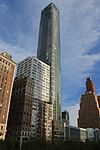St. George's Syrian Catholic Church
Buildings and structures completed in 1812Churches completed in 1929Closed churches in New York CityEastern Catholic churches in New York (state)Eastern Catholicism in New York City ... and 7 more
Financial District, ManhattanFormer Catholic church buildingsLebanese-American culture in New York (state)Melkite Greek Catholic churches in the United StatesNew York City Designated Landmarks in ManhattanSyrian-American culture in New York CityUse mdy dates from July 2020

St. George's Syrian Catholic Church is a former church located at 103 Washington Street between Rector Street and Carlisle Street in the Financial District of Manhattan, New York City. The church is the last physical reminder of the Syrian American and Lebanese American community that once lived in Little Syria.
Excerpt from the Wikipedia article St. George's Syrian Catholic Church (License: CC BY-SA 3.0, Authors, Images).St. George's Syrian Catholic Church
Washington Street, New York Manhattan
Geographical coordinates (GPS) Address External links Nearby Places Show on map
Geographical coordinates (GPS)
| Latitude | Longitude |
|---|---|
| N 40.708416666667 ° | E -74.014166666667 ° |
Address
Washington Street 103
10006 New York, Manhattan
New York, United States
Open on Google Maps








